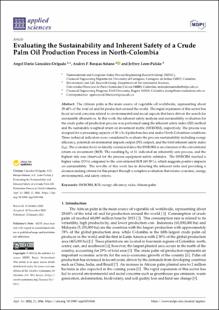Evaluating the Sustainability and Inherent Safety of a Crude Palm Oil Production Process in North-Colombia
Artículo de revista
2021-01-25
Applied Sciences
Suiza
The African palm is the main source of vegetable oil worldwide, representing about 29.60% of the total oil and fat production around the world. The rapid expansion of this sector has faced several concerns related to environmental and social aspects that have driven the search for sustainable alternatives. In this work, the inherent safety analysis and sustainability evaluation for the crude palm oil production process was performed using the inherent safety index (ISI) method and the sustainable weighted return on investment metric (SWROIM), respectively. The process was designed for a processing capacity of 30 t/h of palm bunches and under North-Colombian conditions. Three technical indicators were considered to evaluate the process sustainability including exergy efficiency, potential environmental impacts output (PEI output), and the total inherent safety index (ITI). The economic factor is directly considered since the SWROIM is an extension of the conventional return on investment (ROI). The resulting ITI at 11 indicated an inherently safe process, and the highest risk was observed for the process equipment safety subindex. The SWROIM reached a higher value (53%) compared to the conventional ROI (49.39%), which suggests positive impacts on sustainability. The novelty of this work lies in detecting the inherent risks and providing a decision making criteria for this project through a complete evaluation that relates economic, energy, environmental, and safety criteria.
- Ambiente y Vida - GIAV [124]
Descripción:
Evaluating the Sustainability and Inherent Safety.pdf
Título: Evaluating the Sustainability and Inherent Safety.pdf
Tamaño: 1.796Mb
 PDF
PDF
 LEER EN FLIP
LEER EN FLIP
Título: Evaluating the Sustainability and Inherent Safety.pdf
Tamaño: 1.796Mb
 PDF
PDF
 LEER EN FLIP
LEER EN FLIP
Excepto si se señala otra cosa, la licencia del ítem se describe como 2021 by the authors. Licensee MDPI, Basel, Switzerland. This article is an open access article distributed under the terms and conditions of the Creative Commons Attribution (CC BY) license (https:// creativecommons.org/licenses/by/ 4.0/).

















